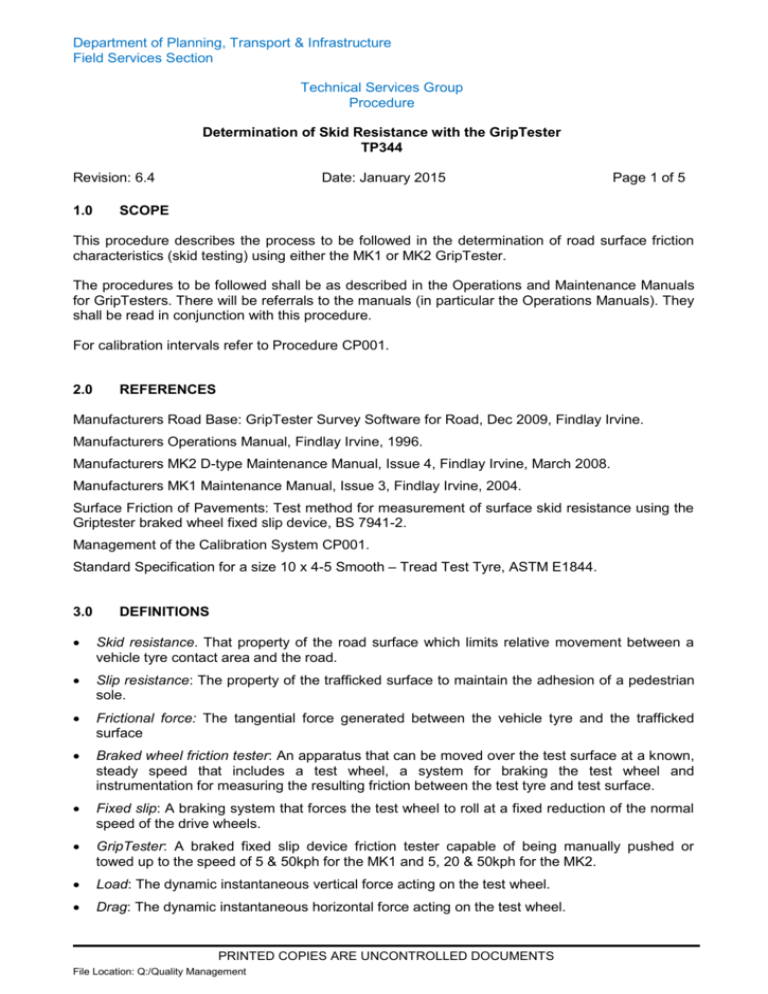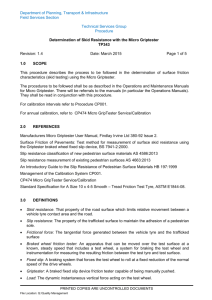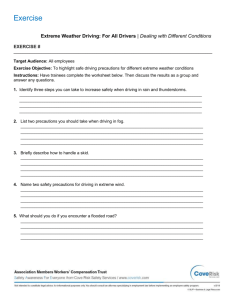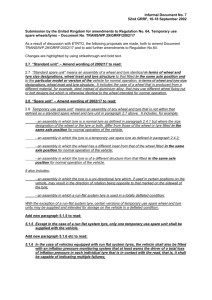TP344 - Department of Planning, Transport and Infrastructure
advertisement

Department of Planning, Transport & Infrastructure Field Services Section Technical Services Group Procedure Determination of Skid Resistance with the GripTester TP344 Revision: 6.4 1.0 Date: January 2015 Page 1 of 5 SCOPE This procedure describes the process to be followed in the determination of road surface friction characteristics (skid testing) using either the MK1 or MK2 GripTester. The procedures to be followed shall be as described in the Operations and Maintenance Manuals for GripTesters. There will be referrals to the manuals (in particular the Operations Manuals). They shall be read in conjunction with this procedure. For calibration intervals refer to Procedure CP001. 2.0 REFERENCES Manufacturers Road Base: GripTester Survey Software for Road, Dec 2009, Findlay Irvine. Manufacturers Operations Manual, Findlay Irvine, 1996. Manufacturers MK2 D-type Maintenance Manual, Issue 4, Findlay Irvine, March 2008. Manufacturers MK1 Maintenance Manual, Issue 3, Findlay Irvine, 2004. Surface Friction of Pavements: Test method for measurement of surface skid resistance using the Griptester braked wheel fixed slip device, BS 7941-2. Management of the Calibration System CP001. Standard Specification for a size 10 x 4-5 Smooth – Tread Test Tyre, ASTM E1844. 3.0 DEFINITIONS Skid resistance. That property of the road surface which limits relative movement between a vehicle tyre contact area and the road. Slip resistance: The property of the trafficked surface to maintain the adhesion of a pedestrian sole. Frictional force: The tangential force generated between the vehicle tyre and the trafficked surface Braked wheel friction tester: An apparatus that can be moved over the test surface at a known, steady speed that includes a test wheel, a system for braking the test wheel and instrumentation for measuring the resulting friction between the test tyre and test surface. Fixed slip: A braking system that forces the test wheel to roll at a fixed reduction of the normal speed of the drive wheels. GripTester: A braked fixed slip device friction tester capable of being manually pushed or towed up to the speed of 5 & 50kph for the MK1 and 5, 20 & 50kph for the MK2. Load: The dynamic instantaneous vertical force acting on the test wheel. Drag: The dynamic instantaneous horizontal force acting on the test wheel. PRINTED COPIES ARE UNCONTROLLED DOCUMENTS File Location: Q:/Quality Management Department of Planning, Transport & Infrastructure Field Services Section Technical Services Group Procedure Determination of Skid Resistance with the GripTester TP344 Revision: 6.4 Date: January 2015 Page 2 of 5 Coefficient of Friction: Drag divided by load. GripNumber: The mean of a number of instantaneous readings over a defined length. GripLength: The defined length over which the GripNumber is produced. Water deposition system: System for depositing a given amount of water in front of the test tyre so that it then passes between the tyre and the surface being measured. Rate of water deposition: Rate at which water is deposited on the surface to be measured in front of the test tyre. Theoretical film thickness: Thickness of the water film that would exist between a test tyre with smooth tread and the surface being measured if this surface had zero texture depth. Routine skid resistance testing: Measurement of the skid resistance of a surface in standardised test conditions, which normally include a defined rate of water deposition. Operational Skid resistance testing: measurement of the skid resistance of a surface in response to an operational need and in whatever conditions exist at the time of the test. 4.0 APPARATUS AND MATERIALS 4.1 Apparatus. MK1 or MK2 GripTester and ancillary equipment. Metered standpipe. Water tank and delivery hoses. The water flow rate shall be measured to the nearest 0.1l/min Lap top computer. Temperature measuring device 0 – 1000C accurate to +10C Safety equipment. Backup vehicle (when required.) 4.2 Materials. Water Smooth tread test wheel manufactured by Findlay Irvine (A Series) and to ASTM E1844. The rubber formulation is designed not to require a temperature correction when being used in a test. Operating pressure is 20+ 1 psi. PRINTED COPIES ARE UNCONTROLLED DOCUMENTS File Location: Q:/Quality Management Department of Planning, Transport & Infrastructure Field Services Section Technical Services Group Procedure Determination of Skid Resistance with the GripTester TP344 Revision: 6.4 Date: January 2015 Page 3 of 5 5.0 PROCEDURE 5.1 The procedure has been developed from operating and maintenance manuals of the Manufacturer as has the Standard BS 7941-2. As the standard makes frequent references to the same manuals it has been treated as a secondary reference in this instance. The GripTester is a precision surface friction tester, which may be towed or pushed by hand. The principle of operation is the simultaneous measurement, using strain gauge sensors, of drag and load on a single wheel of 258 ± 2mm diameter skidding at just under 15% of the rolling speed (a gearing ratio of 27:32 between the test and drive wheels achieves this slip). The coefficient of friction (drag/load) is displayed on a meter mounted on the GripTester and transmitted to a data collection computer. This data collection computer analyses and displays the data in a variety of ways. While the survey is being carried out, it may be interrogated at any time to provide a spot check on the friction readings and the distance from the beginning of the current section. Events such as bridges, bends, junctions and changes of surface may be entered and appropriately labelled. When the survey is finished, the results can be displayed on the data collection computer screen, either in the form of a summary giving the average friction reading for each section, or in the form of a trace. The data may be transferred to any compatible personal computer, where it can be scanned, the events edited and a report produced. Highway friction testing should be carried out when the road is dry, but with a film of water (usually with a nominal thickness of 0.25mm) being deposited under the measuring wheel. When towed both the MK1 and MK2 GripTesters can operate at 50kph with the water being carried in the towing vehicle. MK2 also has the added capability of testing corners and roundabouts, operating at 20kph. In the push mode, operating at 5kph, the GripTester carries its own water tanks. The speed of operation is calculated by on board sensors on the GripTester and is shown on the computer screen when under test. 5.2 Preliminary to Survey Complete the 4 CHECKLIST attached at the end of this procedure and place a copy in each job file. Carry out the Pre-survey check before departure (Clause 2.1 – in both MK1 & MK2 Maintenance Manuals). Should a full calibration be necessary then follow the requirements in clause 2.4 Calibration Procedure. It is important to check the test tyre for compliance as its condition is critical to the test. If the tyre needs to be changed then follow the procedure as in the Maintenance Manual clause 4.1, which includes requirements covering the towing tyres. PRINTED COPIES ARE UNCONTROLLED DOCUMENTS File Location: Q:/Quality Management Department of Planning, Transport & Infrastructure Field Services Section Technical Services Group Procedure Determination of Skid Resistance with the GripTester TP344 Revision: 6.4 5.3 Date: January 2015 Page 4 of 5 Survey When at the work area, carry out “on site” check of equipment. Set up the GripTester for either the pushed or towed mode. This includes the settings on the GripTester with regard to data collection, the software to be used and physical layout. The settings on the GripTester dictate the data collection rates as detailed in operations manual and BS 7941-2. If being towed connect it to the appropriate towing hitch to suit the area to be tested. Prepare the computer and equipment for a survey run, either towed or pushed. See Roadbase User Manual pages 3-5. Measure the required temperatures (to 1.00 C) and measure and set the tyre pressures. Turn on the water to give the required film thickness of 0.25 mm. See Roadbase User manual, page 7. Commence the survey, taking into account the prevailing traffic conditions and any backup vehicle being used is in the correct position. Activate the computer when at the area to be tested by pressing the space bar. Using vehicle speed controls and settings, maintain the speed as required for either a towed (+ 2 km/h) or a (+ 1 km/h) pushed survey. For pushed mode note the test speed on the computer screen. At the end of the survey, press ESC on the computer to cease data collection. Stop the vehicles in a safe position and turn off the water flow. The survey data may now be viewed on the computer screen. Note: If returning to the start of the survey for another run, turn the water flow on to prevent wear of the measuring tyre. If the survey has been over a considerable distance, return to the start of the next run with the GripTester stored in the vehicle. On return to base unload, check and store all equipment. 6.0 POST SURVEY REPORTING 6.1 The resulting data from the survey may be analysed on the dedicated computer using the supplied software or down loaded to a personal computer for analysis, Road Base: User Manual. The client shall be supplied with a copy of the test report. Any interpretation of data or comments relative to the results shall be presented in a separate report. 6.2 Accuracy of reporting. Average, and Standard Deviation (2 decimal places), Coefficient of Variation % (Integer). Sensors measuring drag and load are accurate (three decimal places) enabling the reporting of Grip Numbers to 0.01. PRINTED COPIES ARE UNCONTROLLED DOCUMENTS File Location: Q:/Quality Management Department of Planning, Transport & Infrastructure Field Services Section Technical Services Group Procedure Determination of Skid Resistance with the GripTester TP344 Revision: 6.4 Date: January 2015 Page 5 of 5 6.3 When Griptester is to be operated in push mode, the test interval is to be set at 1m. When the Griptester is operated in tow mode, the test interval is to be set at 10m unless advised otherwise. 6.4 On finalising the report, store the accumulated data on the DPTI network. 6.5 Where required use the Microsoft Processing Package Excel GripTester Macro M:\Field Data Macro to produce a graphical plot reflecting the skid resistance results relative to the DPTI maintenance markers for that section of road. 6.6 On completion, the Griptester data is to be uploaded to the corporate database. 6.7 Details of sites tested are to be recorded on the field testing database. 7.0 DOCUMENTATION TP344-1 form (Checklists) TP344-2 form (Survey Report) TP344-3 form (Field Work Sheet) 8.0 PRECISION The uncertainty of measurement has been determined as + 5.0% of the test result, at a confidence limit of 95% with a nominal coverage factor of 2, when calculated in accordance with the accreditation requirements as detailed in AS/ISO 17025. Uncertainty of Measurement determined by and for DPTI Technical Services Group, Field Services Section. PRINTED COPIES ARE UNCONTROLLED DOCUMENTS File Location: Q:/Quality Management Department of Planning, Transport & Infrastructure Field Services Section Technical Services Group Procedure Determination of Skid Resistance with the GripTester TP344 Revision: 6.4 Date: January 2015 Pre-Survey Check including ‘F.A.C.T.S’ MK# 2 Operator: DATE / 1 Is the Griptester battery charged? (below 10V requires deep charge) 2 Is the water nozzle 20mm clear of the ground? Yes / No 3 Are rollers free spinning? Yes / No 4 Tyres are free from deposits? (e.g. salt, dirt, OIL, etc) Yes / No 5 Has the sprocket remained in the correct position along drive axle? Yes / No 6 Is the toothed wheel covering the proximity sensor? Yes / No 7 Is the proximity sensor cap undamaged & gap between 0.7 - 0.9mm? Yes / No 8 Chain movement at midpoint is? (MK2: 17–22mm) 9 Drive tyre depths are? (needs to be >2mm deep) __._V & __._V = ____mm ____ mm / ____ mm 10 Measuring tyres depths are > 2mm deep? ____ mm 11 Measuring Tyre Identification ___-______ 12 Has chain been lightly lubricated with low viscosity chain oil? Yes / No 13 Free running wheels and transmission system? Yes / No 14 Drive tyres pressure are? (All tyres must be between 20±1psi) _____ psi / _____ psi 15 Measuring tyre pressure is? _____ psi 16 Suspension springs back smartly and there is no yaw? Yes / No 17 Has the Quick Calibration Check been completed? (Clause 2.1.3) ID Ruler143/ / PressureGauge054/ Vernier179/ Feeler173/ V=0______ Thermometer167/ OTHER PRE-CHECKS: 1 Is the water tank full with water? Yes / No / NA 2 Is the standpipe & correct two delivery hoses in the vehicle? Yes / No / NA 3 ‘A’ frame in vehicle? Yes / No / NA 4 Is the calibration kit loaded? Yes / No / NA 5 Spare GripTester tyres, require cables & spare parts in the vehicle? Yes / No / NA 6 Is the spare lap-top computer in the vehicle (including any cables)? Yes / No / NA 7 Test sheets, Maps and USB? Yes / No / NA 8 Do you have first aid kit, safety vests and any other PPE? Yes / No / NA 9 RoadBase Software loads up on notebook? Yes / No / NA 10 Vehicle has enough fuel & jerry-can in vehicle if required? Yes / No / NA 11 Have vehicle pre-check & logbook been filled out? Yes / No / NA Form TP344-1, Revn.6.4 PRINTED COPIES ARE UNCONTROLLED DOCUMENTS File Location: Q:/Quality Management Department of Planning, Transport & Infrastructure Field Services Section Technical Services Group Procedure Determination of Skid Resistance with the GripTester TP344 Revision: 6.4 Date: January 2015 Report No. Client: Address: Grip Testing – Test Mode Date Time Grip Tester Measuring tyre Site Direction Track Pavement location Target speed Self-wetting film Operator Weather Ambient temperature (C) Surface temperature (C) Tyre temperature (C) Water temperature (C) Run number Surface Remarks (1) Remarks (2) : : : : : : : : : : : : : : : : : : : : : Grip Number BP Number Mean Std Deviation Coeff of Variation % Operator: .............................. Title: .................................... Date: / / Signatory: .............................. Title: .................................... Date: / / “This report is subject to the laws of copyright. No part of this report may be reproduced by any means or process without the prior written permission of the Manager, Field ServicesSection, except to the extent that any such reproduction is permitted under the Copyright Act, 1968. Any loss or liability incurred by any person as a consequence of or in connection with the use of or reliance upon the contents of this report shall be at the sole risk of that person. The Crown in right of the State of South Australia, its employees, officers, agents and contractors do not accept any liability for any loss or damage incurred by any person as a consequence of or in connection with the use of or reliance upon the contents of this Report, except to the extent that any such loss or damage is caused by any negligent act or omission of the Crown in right of the State of South Australia, its employees, officers, agents and contractors.” Form TP344-2, Revn.6.4 PRINTED COPIES ARE UNCONTROLLED DOCUMENTS File Location: Q:/Quality Management DEPARTMENT of PLANNING, TRANSPORT & INFRASTRUCTURE Technical Services Group, Field Services Section 19 Bridge Road Walkley Heights SA 5098 Telephone (08) 8260 0320 GPO Box 1533 Adelaide 5001 GRIP TESTER FIELD WORK SHEET Job # Road: ………………………………………………………………………….. Road No: ………….. Metro. / East. / N&W Network / WetCrash / Requested / Accident / Fatal Date:………......... Driver..…….……. Operator ….…..…...... Run No: GT ………………….. Temp…….…...OC Kph: 20 / 50 DPTI Resp. Y / N Texture □ Steps: ...….…… Surface: AC / Spray Seal / Slurry / OG / ……..…….. C6/…………………..………… Carriageway: Northern / Southern / Eastern / Western Repeat Run No: GT……….… Direction: North / South / East / West Texture □ Steps: ………...… Code: Left / Right Lane: 1 / 2 / 3 / 4 C6/………..…………..…....… Wheel Path: Outer / Between / Inner Knet #:……..…….………...... Start: …………………………………………….…………………………….…RRD…………..…… End: ……………………………………………………………………………..RRD……..………… …………………………………………………………………………………………………………… …………….…………………………………………………………………………………………….. ……………………….………………………………………………………………………………..… ………………………………………………………………………………………………………….. ………..………………………………………………………………………………………………… …………………….………….………………………………………………………………………… ………………………………………………………………………………………………………….. Correction Factor = Date:………......... Driver..…….……. Operator ….…..…...... Run No: GT ………………….. Temp…….…...OC Kph: 20 / 50 DPTI Resp. Y / N Texture □ Steps: ...….…… Surface: AC / Spray Seal / Slurry / OG / ……..…….. C6/…………………..………… Carriageway: Northern / Southern / Eastern / Western Repeat Run No: GT……….… Direction: North / South / East / West Texture □ Steps: ………...… Code: Left / Right Lane: 1 / 2 / 3 / 4 C6/………..…………..…....… Wheel Path: Outer / Between / Inner Knet #:……..…….………...... Start: …………………………………………….…………………………….…RRD…………..…… End: ……………………………………………………………………………..RRD……..………… …………………………………………………………………………………………………………… …………….…………………………………………………………………………………………….. ……………………….………………………………………………………………………………..… ………………………………………………………………………………………………………….. ………..………………………………………………………………………………………………… …………………….………….………………………………………………………………………… ………………………………………………………………………………………………………….. Correction Factor = HOURS SIGNED DATE Set Up Processed Pre-checks Database On Site Checked Total Travel Uploaded Plant Hire Y/N Knet Process Sent Check Form TP344-3, Revn.6.4 PRINTED COPIES ARE UNCONTROLLED DOCUMENTS File Location: Q:/Quality Management






